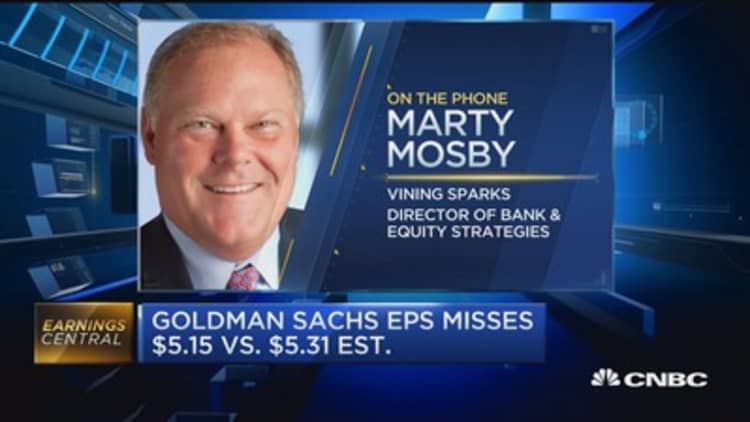
Goldman Sachs' stunning first-quarter profit disappointment immediately set off some serious head-scratching on Wall Street.
The fifth-largest bank by assets in the U.S. reported earnings that missed on both top-line revenue and bottom-line profits, a rarity for a bank that historically has beaten Wall Street earnings targets 9 out of 10 times.
Time will tell if the first three months of 2017 were a one-off miss or a sign of a more fundamental decline in the bank's operations. But for now, the letdown was palpable and set off a wave of investor worry, particularly because Goldman's competitors posted almost universally strong earnings.
The bank's shares tumbled more than 3 percent at the market open and were down 4.5 percent at one point, falling to $216.02. It was the lowest intraday price since it traded at 214.97 on Nov. 30.
"Given what you're seeing out of Bank of America, JPMorgan and Citigroup, this is a quarter which makes me wonder what the heck is going on," said Dick Bove, vice president of equity research at Rafferty Capital Markets. "Hopefully, it's just an aberrant quarter."
Bove later on Tuesday cut his rating on Goldman from a "buy" to a "hold."
Goldman's biggest area of worry was in trading, where revenues in the vital fixed income, commodities and currencies business were essentially flat year over year and down about 16 percent from the fourth quarter of 2016.
The new year has been slow for equities trading, but other big institutions on the Street are making due with strong business in bonds and related debt instruments.
"The big one that is glaring and sticks out is the decline in FICC. That was totally unexpected and totally aberrant as to what its competitors are doing," Bove said.
One of the big problems for Wall Street in general and Goldman Sachs in particular has been the absence of deals.
Mergers and acquisitions volume plunged 55 percent in the first quarter from Q4 in 2016, according to data provider Dealogic. While initial public offering volume surged in the quarter, much of it came via the Snap IPO that generated $3.9 billion of the total $13.4 billion in revenue raised during the quarter.
"Look at the equity markets — there's nothing going on. The IPO pipeline is small and as unremarkable as I can remember," said Christopher Whalen, head of Whalen Global Advisors. "We're not funding acquisitions or deals. It's simply the Street refinancing the debt they're using to buy back their stock."
The competition for deals is intense, and the benefits are skewing toward bigger firms that have dominated and smaller ones that are willing to compete for down-market business.
"Goldman's been good at trading, but you're not going to hit that every quarter and you can't predict it. One or two trades can seriously affect your results every quarter," Whalen said. "It's Jurassic Park — that's what you've got, and the big dinosaurs win."
The long-term damage for Goldman is hard to predict as well.
Shares are down more than 9 percent in 2017, sharply underperforming an industry that is off about 5 percent as measured by the SPDR S&P Bank exchange-traded fund.
Goldman CEO Lloyd Blankfein told investors Tuesday that the bank is "well-positioned" to meet the challenges ahead.
"I don't think it's worrisome. It's probably just a one-off kind of a quarter. You'll probably see it improve at least to the extent that volatility begets more client activity over the next few quarters," said Justin Fuller, senior director at Fitch Ratings. "I don't think it's a bad quarter by any means."


